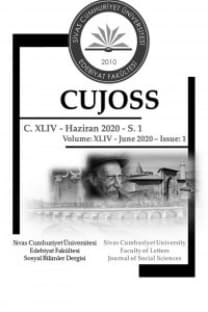KAPI ANAHTARLARI VE UYDULAR: NOËL COWARD’IN PRESENT LAUGHTER ADLI ESERİNDE SADAKAT KAVRAMI
Noël Coward, Sadakat, Present Laughter, Uydular, Kapı Anahtarı
LATCHKEYS AND SATELLITES: CONCEPT OF LOYALTY IN NOËL COWARD’S PRESENT LAUGHTER
Noël Coward, Loyalty, Present Laughter, Satellites, Latchkey,
___
Burns, G. J. (1999). Private Lives: The Presentation of Marriage in English Drama 1930 - 1990. (Publication No. 0800949) [Doctoral dissertation, University of New South Wales]. ProQuest Dissertations & Theses Global.Coward, N. (1954). The Collected Plays of Noël Coward: Play Parade Vol. IV (Tonight at 8.30, Present Laughter, This Happy Breed). London: William Heinemann.
Coward, N. (1979). Plays: Four (Blithe Spirit, Present Laughter, This Happy Breed, Tonight at 8.30). London: Methuen.
Dinçel, M. S. (1989). Technical and thematic developments in three representative comedy of manners: Wycherley's The Country Wife, Etherege’s The Man of Mode and Congreve's The Way of the World. (Publication No. 7647) [Master's thesis, Hacettepe University]. Yükseköğretim Kurulu Ulusal Tez Merkezi. https://tez.yok.gov.tr/UlusalTezMerkezi/tezDetay.jsp?id=uPiaa6yuHLAaAEcfwxFOgQ&no=uPiaa6yuHLAaAEcfwxFOgQ
Gray, F. (1987). Macmillan Modern Dramatists: Noel Coward. London: Macmillan.
Gray, F. (2006). Always Acting: Noël Coward and the Performing Self. In M. Luckhurst (Ed.), A Companion to Modern British and Irish Drama, 1880-2005 (pp. 225-236). Malden, MA: Blackwell.
Hirst, D. L. (1979). Comedy of Manners. London: Methuen.
Hoare, P. (1996). Noël Coward: A Biography. New York: Simon & Schuster.
Kaya, K. (2012). Alan Ayckbourn’un ‘Absurd Person Singular’ Oyununda Evlilik Kurumu. Cumhuriyet Üniversitesi Edebiyat Fakültesi Sosyal Bilimler Dergisi, 36(2), 121-138. Retrieved from https://dergipark.org.tr/tr/pub/cumusosbil/issue /4347/59452
Lahr, J. (1982). Coward, the Playwright. London: Bloomsbury Methuen Drama.
Mander, R. (Ed.). (1957). Theatrical Companion to Coward: A Pictorial Record of the First Performances of the Theatrical Works of Noël Coward. New York: The Macmillan Company.
Merriam-Webster. (2004). Loyal. In Merriam-Webster's Collegiate Dictionary (11. ed., p. 738). Springfield, MA: Merriam-Webster, Incorporated.
Paterson, A. M. (1978). High Comedy in the British Theatre of the Nineteen Thirties. (Publication No. 10868003) [Master's thesis, University of Glasgow]. ProQuest Dissertations & Theses Global.
Rebellato, D. (1999). 1956 And All That: The Making of Modern British Drama. London: Routledge.
Rogers, C. S. W. (1972). Dramatic Structure In The Comedies Of Noel Coward: The Influence Of The Festive Tradition. (Publication No. 7231427) [Doctoral dissertation, The Florida State University]. ProQuest Dissertations & Theses Global.
Royce, J. (1908). The Philosophy of Loyalty. New York: The Macmillan Company.
Yaravintelimath, C. R. (1975). The Comic Vision of Noel Coward. [Doctoral dissertation, Karnatak University]. INFLIBNET Centre. http://hdl.handle.net/10603/93811
- ISSN: 1305-5143
- Yayın Aralığı: 2
- Yayıncı: Sivas Cumhuriyet Üniversitesi Edebiyat Fakültesi
KENT BELLEĞİNİN YANSIMA ALANI OLARAK CADDE ADLARI: SİVAS ÖRNEĞİ
TÜRKİYE’DE ENGELLİLİK YAKLAŞIMLARININ SOSYAL POLİTİKA AÇISINDAN DEĞERLENDİRİLMESİ
LUDWIG von MISES: DEVLETÇİLİK ELEŞTİRİSİ
ÖĞRETMEN ADAYLARININ DİJİTAL BAĞIMLILIĞI İLE AKADEMİK BAŞARILARI ARASINDAKİ İLİŞKİNİN İNCELENMESİ
SİVAS HALK OYUNLARI BİBLİYOGRAFYASI
TOPLUM SAĞLIĞININ YÖNETİMİ: SAĞLIK OKURYAZARLIĞI VE AŞIYA İLİŞKİN TUTUM ARASINDAKİ İLİŞKİ
ERKEKLERİN BOŞANMA SÜRECİNE İLİŞKİN DENEYİMLERİ: DENİZLİ'DE NİTEL BİR ÇALIŞMA
TANRIÇA KYBELE’NİN MYSİA BÖLGESİNDEKİ İZLERİ
Korkmaz MERAL, Tuba AYDIN ÇAKMAK
KONYA İLİ BOZKIR İLÇESİ ÇEVRESİNDEKİ BİR GRUP AHŞAP DİREKLİ CAMİ
